Abstract
In the Centennial and Henry’s Mountains of Idaho and Montana north of Island Park, at least 40 km3 (maximum thickness >350 m) of Eocene shoshonite aa lava flows overlie local Paleozoic strata. The volcanic features, petrography, composition, and ages of these flows vary little throughout the section. Compositions of these rocks are uniformly shoshonitic, silica-oversaturated, magnesian, and calc-alkalic—and indicate that the original magmas are more like the mafic rocks of the Absaroka Volcanic Field that lies to the east and less like equivalent compositions from the Challis Volcanic Field that lies to the northwest. Variations in major and trace element compositions indicate that the magma that produced these flows evolved by fractional crystallization and mixing from primitive magma containing a subduction zone compositional component.
Introduction
The Centennial and Henry’s Mountains lie on the Idaho-Montana border and are, respectively, east-west- and north-south-trending ranges located inside the Yellowstone tectonic parabola near the eastern margin of the Basin and Range Province (Figure 1A). The Eocene igneous rocks exposed in these ranges represent a small, deeply eroded Eocene volcanic field that we refer to as the Centennial-Henry’s Mountains volcanic field (CHM). Today, the CHM is exposed in three areas, from west to east: in the Centennial Mountains west of Mount Jefferson and at Sawtell Peak and in the Henry’s Mountains near Mount Two Top (Figure 1). During the Eocene, this area lay just south of the Madison-Gravelly Arch, a north-south trending topographic high [1]. The CHM lies between two of the largest Eocene volcanic fields in North America—the Absaroka and Challis Volcanic Fields, located 80 km to the east and 120 km to the west, respectively. The Absaroka volcanic field was dominated by composite volcanoes, was primarily active 55-44 Ma, and records compositions typical of subduction settings [2-10]. The Challis volcanic field, which is part of the Challis-Kamloops volcanic belt, contains remnants of composite volcanoes and calderas, was active 51-44 Ma, and records compositions interpreted to represent the opening of a window in the underlying subducted slab [3,6,10-16]. This study reports the field relations, petrography, and compositions of the CHM, evaluates the affinity of the CHM to nearby volcanic fields, and assesses the source and compositional evolution of CHM magma.

Figure 1: Geographic reference map (A [23]) and geologic map (B [24]) for the Centennial-Henry’s Mountains volcanic field (CHM) showing the distribution of Eocene volcanic rocks and related features
Field Relations and Petrography
Standard 1:24,000 scale geologic mapping and petrographic work indicates that the volcanic features and petrography of CHM rocks are remarkably uniform—consisting almost exclusively of sequences of shoshonite aa flows that are one to ten meters thick (Figure 2A). Where slopes are steep, the cross sections of individual flow lobes are exposed (Figure 2B). CHM flows are crystal rich, contain euhedral clinopyroxene (cpx) phenocrysts and subhedral olivine (ol) phenocrysts that are commonly altered to iddingsite, include microlites of plagioclase and Fe-Ti oxides, and are sometime vesicular or amygdaloidal (Figure 2C). Modal proportions are 61-69% groundmass, 22-34% cpx, and 5-12% ol, and rocks with more cpx contain less ol. Three units contain minor phlogopite. No pyroclastic rocks or lahar deposits were observed. In very few locations (Figure 1B) there are small deposits of locally derived volcanic sediments between lava flows. CHM lava flows are cut by northwest-southeast trending vertical feeder dikes that are typically one to five meters thick. Some dikes have chilled margins, while others are surrounded by zones of hydrothermal alteration. Surface exposures of the large dikes are up to 100 m long. The absence of a clear eruptive center and scarcity of large dikes suggest that the eruptive center for CHM is no longer exposed. The orientations of CHM flows suggest that the eruptive center may lie north of Sawtell Peak (Figure 1B). 40/39Ar ages (of the oldest exposed flow exposed at the base of Sawtell Peak and of the youngest flows from there and exposures to the west; Figure 1B) are unable to resolve a difference between the initiation and cessation of volcanism in the Sawtell Peak volcanic field—suggesting the flows erupted in a short period at 50 Ma, in the early Eocene [16-25]. Field relations support rapid accumulation of lava flows. For example, the sequence of flows commonly preserves easily eroded flow tops and records no significant disconformities.
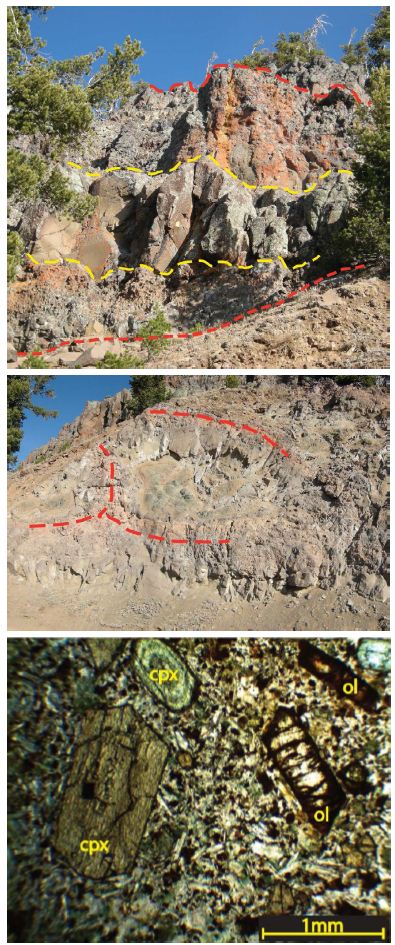
Figure 2: A) Photo of a typical CHM aa flow showing a thin lower rubble zone, a dense interior, and thick upper rubble zone. B) Photo of several lava flow lobes. Outlines lie in the flow breccia carapaces surrounding dense flow interiors. C) Thin section photomicrograph of a CHM shoshonite showing phenocrysts of clinopyroxene (cpx) and olivine (ol) in a groundmass containing microlites of plagioclase and Fe-Ti oxides.
Composition, Affinity, and Source
Whole-rock major- and trace-element analyses were obtained by wavelength dispersive X-ray fluorescence spectrometry at Brigham Young University, Provo following standard techniques (described at www.geology.byu.edu/faculty/ehc under the heading ‘resources’). The complete dataset is reposited in the EarthChem database (earthchem.org). Figure 3 plots CHM compositions relative to those from the Absaroka and Challis volcanic fields. CHM rocks are shoshonites and latites, shoshonitic (K2O 2-5%), silica-oversaturated, magnesian, and calc-alkalic to alkali-calcic (Figure 3A-C, I). Sundell [17] identified three magmatic groups from the Absaroka volcanic field, and Bray [4] argued for the combination of two of Sundell’s groups—resulting in two groups, the Sunlight and Washburn—Thorofare Creek groups. Although CHM compositions share compositional characteristics with Challis and both Absaroka groups, CHM lava flows are most like the Absaroka Sunlight group. Comparing Y and Nb compositions (Figure 4) emphasize the similarity of CHM and Absaroka compositions, which uniformly plot in the ‘volcanic arc’. In contrast, the Challis compositions display an early subduction component in the mantle source that disappears through time. We interpret compositional data to indicate that the CHM is part of the Absaroka volcanic field and resulted from partial melting from a mantle source with a subduction zone compositional component.
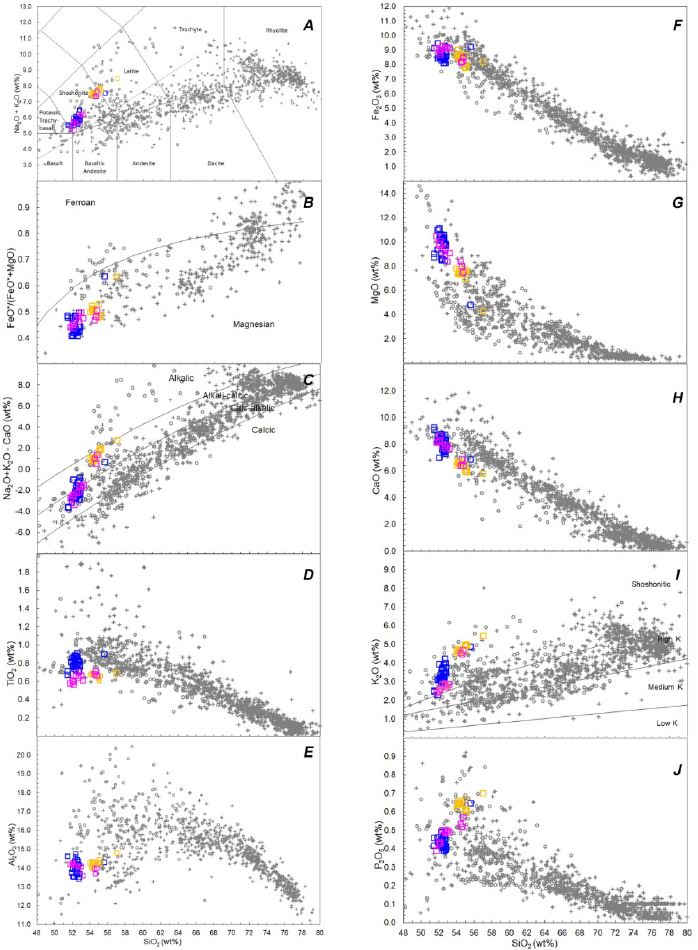
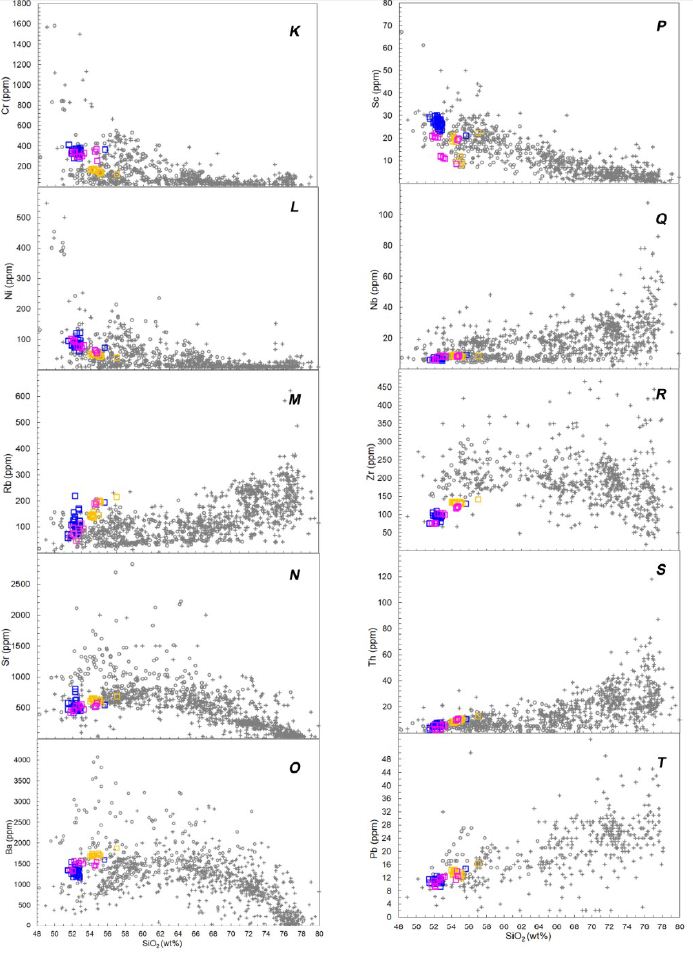
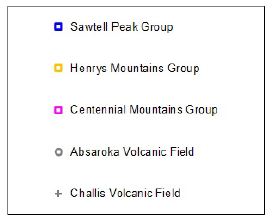
Figure 3: Classification and Harker variation diagrams for major and trace element compositions of CHM samples plotted relative to the compositions the Absaroka Volcanic Field [4, 7, 8, 10, 13]. A) IUGS classification diagram based on total alkalis (Na2O + K2O) versus SiO2 [21]. B) The SiO2 versus FeOtotal/(FeOtotal + MgO) classification diagram of Frost [20], using the dividing line of Miyashiro [22]. C) Modified alkali-lime versus SiO2 diagram of Frost [20]. I) K2O versus SiO2 using the classification lines of Ewart [19].
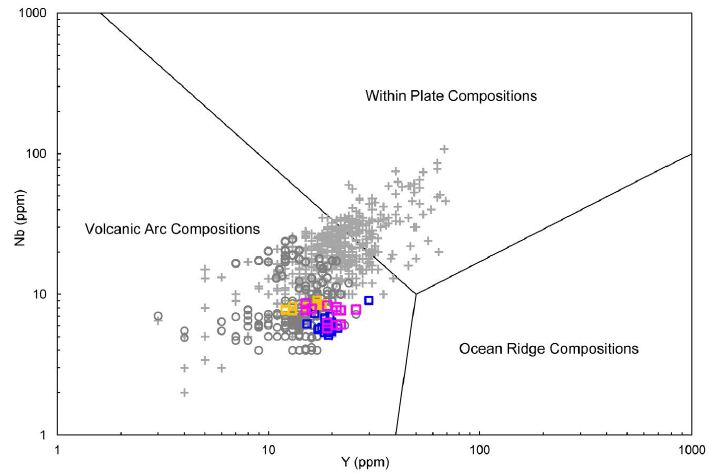
Figure 4: Y versus Nb tectonic discrimination diagram of Pearce (1984) showing that CHM and Absaroka rocks have volcanic arc compositions, while Challis rocks plot in both the volcanic arc (for early magmatism) and intraplate (for late magmatism) fields.
Magmatic Evolution
Major- and trace-element trends on Harker variation diagrams (Figure 3) suggest mineral control in the evolution of CHM magma but are too incoherent to be explained by evolution along a single line of descent. Trace-element modeling of fractional crystallization used a primitive Absaroka composition as the starting point. Figure 5 shows the fractional crystallization model, was applied to all trace elements with similar results, for Rb, Sc, V, and Cr compositions. It also shows a magma mixing line that connects primitive and evolved compositions. Together, these models define an envelope of magma mixing and fractional crystallization that is consistent with the compositional differentiation of CHM magma. he role of assimilation of crustal material can be assessed most effectively with isotopic data; however, the variability of incompatible trace elements (and their ratios) can be a reasonably good indicator of open-system processes. The variations of these elements suggest that assimilation did not play an important role in the development of CHM magma. In short, we propose that fractional crystallization and magma mixing controlled the evolution of CHM magma.
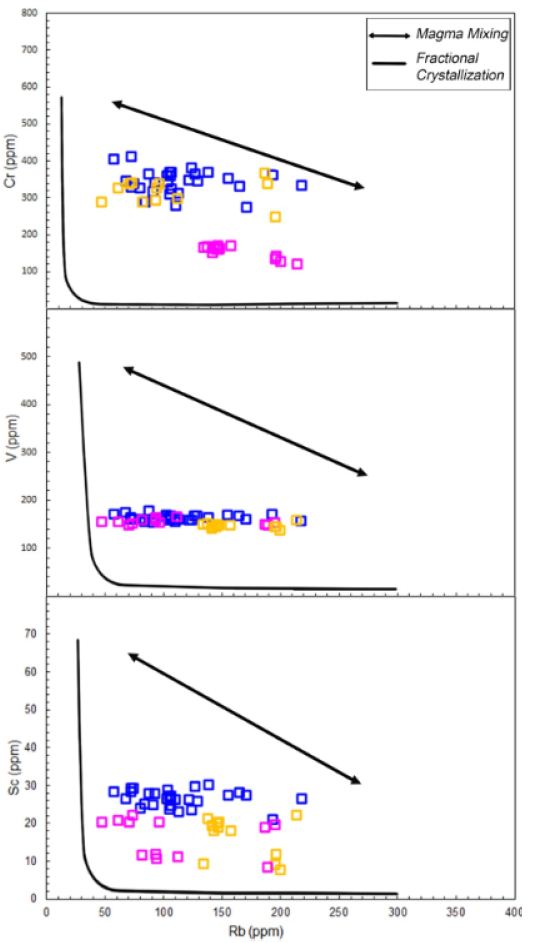
Figure 5: Petrogenetic modeling diagrams for Rb, Sc, V, and Cr showing a fractional crystallization model and a magma mixing line that connects primitive and evolved compositions. The model suggests that CHM magma evolved by magma mixing and fractional crystallization. The Rayleigh fractional model employed the following mineral mode and partition coefficients were used: Ol = 6.7%; Cpx = 24.1%; Plag = 2.8%; Other = 0.2%; DRb bulk=0.013; DSc bulk=5.322; DCr bulk=2.172; DV bulk=0.316.
References
- Chetel LM., Janecke SU, Carroll AR, Beard BL, Johnson CM., et al. (2011) Paleogeographic reconstruction of the Eocene Idaho River, North American Cordillera. Geological Society of America Bulletin. 123: 71-88.
- Armstrong RL (1991) Evolving geographic patterns of Cenozoic magmatism in the North American Cordillera: the temporal and spatial association of magmatism and metamorphic core complexes. Journal of Geophysical Research 96: 13201-13244.
- Luedke RG (1994) Miscellaneous Investigations Series – U. S. Geological Survey Maps showing distribution, composition, and age of early and middle Cenozoic volcanic centers in Idaho, Montana, west-central South Dakota, and Wyoming, U.S. Geological Survey Map I-2291-C.
- Bray EL (1999) Geochemical and Isotopic Variations in the Absaroka Volcanic Supergroup, Wyoming – Implications on Petrogenesis and Magma Sources [M.Sc. Thesis]. Provo, Brigham Young University, pg: 133.
- Hiza MM (1999) The geochemistry and geochronology of the Eocene Absaroka volcanic province, northern Wyoming and Southwest Montana, USA [Ph.D. Thesis]. Eugene, University of Oregon pg: 262.
- Feeley TC, Cosca MA, Lindsay CR (2002) Petrogenesis and implications of calc-alkaline cryptic hybrid magmas from Washburn Volcano, Absaroka Volcanic Province, USA. Journal of Petrology 43: 663-703.
- Feeley (2003) Origin and tectonic implications of across-strike geochemical variations in the Eocene Absaroka volcanic province, United States. Journal of Geology 111: 329-346.
- Feeley TC, Cosca MA (2003) Time vs. composition trends of magmatism at Sunlight Volcano, Absaroka volcanic province, Wyoming. Geological Society of America Bulletin 115: 714-728.
- Lindsay CR, Feeley TC (2003) Magmagenesis at the Eocene Electric Peak-Sepulcher Mountain Complex, Absaroka volcanic province, USA. Lithos 67: 53-76.
- Chandler MR (2006) The Provenance of Eocene Tuff Beds in the Fossil Butte Member of the Green River Formation, Wyoming: Relation to the Absaroka and Challis Volcanic Fields [M.Sc. Thesis]. Provo, Brigham Young University, pg: 89.
- Ekren EB (1985) Eocene cauldron-related volcanic events in the Challis Quadrangle, in Symposium on the geology and mineral deposits of the Challis. USGS 1: 43-58.
- Lewis RS, Kiilsgaard TH (1991) Eocene plutonic rocks in south central Idaho. Journal of Geophysical Research 96: 13295-13311.
- Norman MD, Mertzman SA (1991) Petrogenesis of Challis Volcanics from central and southwestern Idaho: trace element and Pb isotopic evidence. Journal of Geophysical Research 96.
- Jellinek AM (1994) The Twin Peaks Caldera, Challis, Idaho: a unique window into the emplacement and evolution of a caldera-filling ignimbrite [M.Sc. Thesis]: Moscow, University of Idaho, pg: 202 .
- MacDonald WD, Palmer HC, Hayatsu A (1998) Structural rotation and volcanic source implications of magnetic data from Eocene volcanic rocks, SW Idaho. Earth and Planetary Science Letters 156: 225-237.
- Breitsprecher K, Thorkelson DJ, Groome WG, Dostal J (2003) Geochemical confirmation of the Kula-Farallon slab window beneath the Pacific Northwest in Eocene time. Geology 31: 351-354.
- Turrin B (2011) personal communication, Rutgers University.
- Sundell KA (1993) A geologic overview of the Absaroka volcanic province. Geological Survey of Wyoming Memoir 5: 480-506.
- Ewart A (1982) The mineralogy and petrology of Tertiary-Recent orogenic volcanic rocks with special reference to the andesitic-basaltic compositional range, in Thorpe, R.S., ed., Orogenic Andesites and Related Rocks. John Wiley and Sons pg: 25-95.
- Frost BR (2001) A geochemical classification for granitic rocks. Journal of Petrology 42: 2033-2048.
- Le Bas MJ (1991) The IUGS systematics of igneous rocks. Journal of the Geological Society of London 148: 825-833.
- Miyashiro A (1974) Volcanic rock series in island arcs and active continental margins. American Journal of Science 274: 321-355.
- Moye FJ, Hackett WR, Blakley JD, Snider LG, Link PK (1988) Regional geologic setting and volcanic stratigraphy of the Challis volcanic field, central Idaho, Guidebook to the geology of central and southern Idaho. Idaho Geological Survey Bulletin pg: 87-97.
- O’Neill JM, Christiansen RL (2004) Geologic map of the Hebgen Lake Quadrangle, Beaverhead, Madison, and Gallatin Counties, Montana; Park and Teton Counties, Wyoming; and Clark and Fremont Counties, Idaho. U. S. Geological Survey Map 2816.
- Pearce JA, Harris NBW, Tindle AG (1984) Trace element discrimination diagrams for the tectonic interpretation of granitic rocks. Journal of Petrology 25: 956-983.